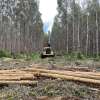
Riparian plantings: Multiple benefits for farms and waterways
Posted 06 March 2024
On-farm benefits Tree Alliance
Restoration of riparian areas on farms through native species plantings brings many benefits, from biodiversity and habitat, to increased flood resilience, farm productivity and water quality improvements. Planning is important to ensure that riparian areas are protected from browsing and contain the right species for upper, mid and lower bank zones.
Why restore riparian areas?
Every piece of land with a river, stream or other waterway has a riparian area where water meets the land. Some riparian areas are healthy, marked by a wide variety of native and multi-level vegetation with good water quality; others are degraded, marked by poor water quality, bank erosion and weeds.
Jesse Webster, NRM North’s Water Program Manager, discusses why it’s important to establish and maintain healthy riparian areas on farms.
"Riparian vegetation provides both habitat and biodiversity, as well as connectivity on a local farm scale and a landscape level,’ says Jesse. "It prevents bank erosion, so there’s increased resilience to flooding. In flood recovery programs, where you have a loss in riparian vegetation, you see bank erosion.
"Riparian plantings also provide shade and shelter. And of course, improved water quality. That’s one of the key benefits."

Roaming stock and riparian areas
Stock roaming into riparian areas and waterways is one of the biggest issues for riparian vegetation communities and water quality of the stream or river.
"When animals have access to waterways, they contribute to the pathogens within those waterways through defecating," says Jesse, "that creates a risk to human and animal health, especially if livestock are drinking out of that water. It can cause sickness, or death in worst-case scenarios.
"Having animals access the waterways also affects the vegetation itself: they’ll browse on it and trample it. Depending on the numbers and how long they’ve been there, that’s going to lead to eroding riverbanks, which leads to water quality issues.
"So our number one recommended activity is to remove stock access by building a fence. Installing alternative watering points is another big priority. If you already have a water system, you can build off that with new pipes and troughs. If you’re starting from scratch, there will be a significant investment needed."
Preparing the site
Fencing off a riparian area, particularly those with remnant vegetation, may bring unexpected results and lessen the need for restoration work. In the absence of stock, sedges and grasses can start growing taller, filtering and limiting nutrient and chemical run-off into waterways, and providing shelter against extreme weather for stock in adjacent paddocks.
"Don’t rush into planting straight away," says Jesse, ‘if possible, fence off the area and wait. Many landholders have been quite surprised how native vegetation bounced back once stock were removed.
"Spend a bit of time for the next year just watching and seeing what happens before you commit to spending money on planting.’
In other cases, riparian areas may have competing species such as blackberry, gorse, hawthorn or willow, which will need to be managed as a first step.
"When you’re working from scratch, you have to do weed management and ongoing spraying,’ says Jesse, ‘site prep could even take a few years before you plant."

Planting riparian areas
Where plantings are required, it’s important to consider the different areas that make up a riparian zone: the upper, mid and lower banks. Each area requires a different type of plant and species.
"Traditionally it’s trees for the upper bank, a mixture of trees and shrubs the middle bank, and sedges and rushes for the lower bank," says Jesse, "if you don’t get this right, you can fail really easily.
Prior to planting, landholders should take time to carefully plan for browsing and pest control, as well as ordering stock. Timing is key to successful revegetation.
"Make sure you have a good understanding of browsing pressure and how you’ll manage that,’ says Jesse, ‘it could be guards and stakes, it could be repellent, it could be ongoing pest control, it could be all three. If you underestimate browsing pressure, they can decimate plants and it’s extremely disheartening.
"Make sure you order your stock the year before," adds Jesse, "a lot of people get to autumn and call the nursery to plant in winter, but then you’ll be left with whatever’s on the shelf that may or may not work for your site.
"Then try to get the plants in as early as possible. Winter is optimal but it also depends on the dryness factor. In a wet year, you might have to wait a bit longer for things to dry out, but you also want to do it before it starts getting too warm."
It is also advised not to remove snags – tree branches, limbs or whole trees that fall into or beside a waterway – which provide excellent habitat while helping to trap sediment and form natural weirs.
A home for wildlife
Healthy riparian areas with native plant and tree species provide habitat for a huge range of wildlife – both land and water dwelling animals. Riparian areas often include large old trees with hollows, for example, which are very rare in farm landscapes yet provide critical habitat for birds, mammals and reptiles. Tasmanian waterways are also home to a wide variety of animals, including native fish, frogs, rakali (water rats) and platypus.
Loss of habitat is one of the leading threats for Tasmanian wildlife. Protecting and maintaining healthy riparian areas offers vital foraging and breeding environments, supporting ecosystems to thrive both on your farm and in the surrounding catchment.
For resources and advice about establishing and managing trees on your property, contact Pierre Defourny at pdefourny@tasland.org.au.
For resources and advice about establishing and managing trees on your property, visit treealliance.com.au or contact Private Forest Tasmania’s free hotline 1300 661 009






